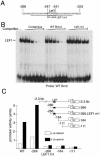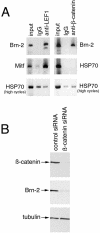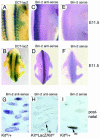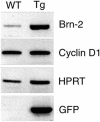Brn-2 expression controls melanoma proliferation and is directly regulated by beta-catenin
- PMID: 15024079
- PMCID: PMC371132
- DOI: 10.1128/MCB.24.7.2915-2922.2004
Brn-2 expression controls melanoma proliferation and is directly regulated by beta-catenin
Abstract
Constitutive activation of the Wnt/beta-catenin signaling pathway is a notable feature of a large minority of cases of malignant melanoma, an aggressive and increasingly common cancer. The identification of target genes downstream from this pathway is therefore crucial to our understanding of the disease. The POU domain transcription factor Brn-2 has been implicated in control of proliferation and melanoma survival, and its expression is strongly upregulated in melanoma. We show here that in vivo Brn-2 is expressed in melanocytes but not in embryonic day 11.5 melanoblasts and that its expression is directly controlled by the Wnt/beta-catenin signaling pathway in melanoma cell lines and in transgenic mice. Moreover, silent interfering RNA-mediated inhibition of Brn-2 expression in melanoma cells overexpressing beta-catenin results in significantly decreased proliferation. These results, together with the observation that BRAF signaling also induces Brn-2 expression, reveal that Brn-2 is a focus for the convergence of two key melanoma-associated signaling pathways that are linked to cell proliferation.
Figures






References
-
- Behrens, J., J. P. von Kries, M. Kuhl, L. Bruhn, D. Wedlich, R. Grosschedl, and W. Birchmeier. 1996. Functional interaction of beta-catenin with the transcription factor LEF-1. Nature 382:638-642. - PubMed
-
- Bert, A. G., J. Burrows, A. Hawwari, M. A. Vadas, and P. N. Cockerill. 2000. Reconstitution of T cell-specific transcription directed by composite NFAT/Oct elements. J. Immunol. 165:5646-5655. - PubMed
-
- Cadigan, K. M., and R. Nusse. 1997. Wnt signaling: a common theme in animal development. Genes Dev. 11:3286-3305. - PubMed
-
- Chin, L., G. Merlino, and R. A. Depinho. 1998. Malignant melanoma: modern black plague and genetic black box. Genes Dev. 12:3467-3481. - PubMed
Publication types
MeSH terms
Substances
LinkOut - more resources
Full Text Sources
Other Literature Sources
Medical
Molecular Biology Databases
Research Materials
Miscellaneous
